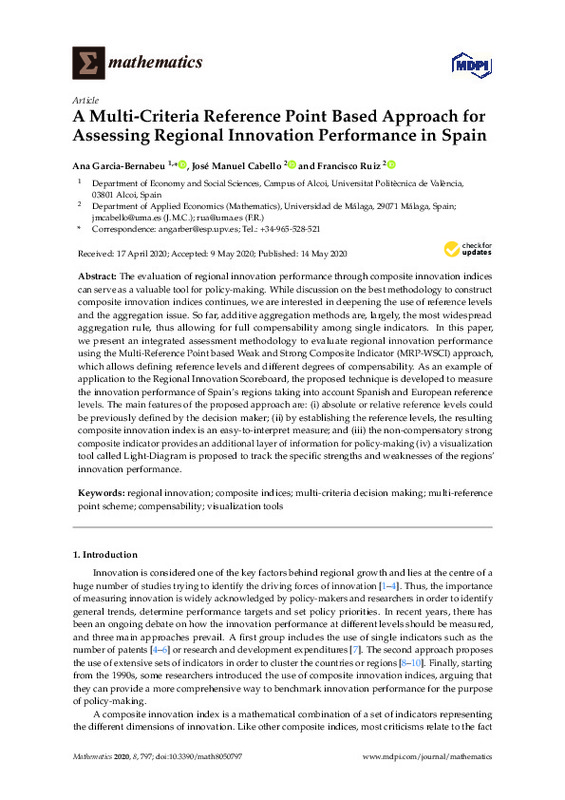Hauser, C., Siller, M., Schatzer, T., Walde, J., & Tappeiner, G. (2018). Measuring regional innovation: A critical inspection of the ability of single indicators to shape technological change. Technological Forecasting and Social Change, 129, 43-55. doi:10.1016/j.techfore.2017.10.019
Makkonen, T., & van der Have, R. P. (2012). Benchmarking regional innovative performance: composite measures and direct innovation counts. Scientometrics, 94(1), 247-262. doi:10.1007/s11192-012-0753-2
Asheim, B. T., Smith, H. L., & Oughton, C. (2011). Regional Innovation Systems: Theory, Empirics and Policy. Regional Studies, 45(7), 875-891. doi:10.1080/00343404.2011.596701
[+]
Hauser, C., Siller, M., Schatzer, T., Walde, J., & Tappeiner, G. (2018). Measuring regional innovation: A critical inspection of the ability of single indicators to shape technological change. Technological Forecasting and Social Change, 129, 43-55. doi:10.1016/j.techfore.2017.10.019
Makkonen, T., & van der Have, R. P. (2012). Benchmarking regional innovative performance: composite measures and direct innovation counts. Scientometrics, 94(1), 247-262. doi:10.1007/s11192-012-0753-2
Asheim, B. T., Smith, H. L., & Oughton, C. (2011). Regional Innovation Systems: Theory, Empirics and Policy. Regional Studies, 45(7), 875-891. doi:10.1080/00343404.2011.596701
Buesa, M., Heijs, J., & Baumert, T. (2010). The determinants of regional innovation in Europe: A combined factorial and regression knowledge production function approach. Research Policy, 39(6), 722-735. doi:10.1016/j.respol.2010.02.016
Di Cagno, D., Fabrizi, A., Meliciani, V., & Wanzenböck, I. (2016). The impact of relational spillovers from joint research projects on knowledge creation across European regions. Technological Forecasting and Social Change, 108, 83-94. doi:10.1016/j.techfore.2016.04.021
Capello, R., & Lenzi, C. (2012). Territorial patterns of innovation: a taxonomy of innovative regions in Europe. The Annals of Regional Science, 51(1), 119-154. doi:10.1007/s00168-012-0539-8
Navarro, M., Gibaja, J. J., Bilbao-Osorio, B., & Aguado, R. (2009). Patterns of Innovation in EU-25 Regions: A Typology and Policy Recommendations. Environment and Planning C: Government and Policy, 27(5), 815-840. doi:10.1068/c0884r
Pinto, H. (2009). The Diversity of Innovation in the European Union: Mapping Latent Dimensions and Regional Profiles. European Planning Studies, 17(2), 303-326. doi:10.1080/09654310802553571
Ruiz, F., El Gibari, S., Cabello, J. M., & Gómez, T. (2020). MRP-WSCI: Multiple reference point based weak and strong composite indicators. Omega, 95, 102060. doi:10.1016/j.omega.2019.04.003
Hollenstein, H. (1996). A composite indicator of a firm’s innovativeness. An empirical analysis based on survey data for Swiss manufacturing. Research Policy, 25(4), 633-645. doi:10.1016/0048-7333(95)00874-8
Gu *, W., & Tang, J. (2004). Link between innovation and productivity in Canadian manufacturing industries. Economics of Innovation and New Technology, 13(7), 671-686. doi:10.1080/1043890410001686806
Tang, J., & Le, C. D. (2007). Multidimensional Innovation and Productivity. Economics of Innovation and New Technology, 16(7), 501-516. doi:10.1080/10438590600914585
Kumar, S., Haleem, A., & Sushil. (2019). Assessing innovativeness of manufacturing firms using an intuitionistic fuzzy based MCDM framework. Benchmarking: An International Journal, 26(6), 1823-1844. doi:10.1108/bij-12-2017-0343
Grupp, H., & Mogee, M. E. (2004). Indicators for national science and technology policy: how robust are composite indicators? Research Policy, 33(9), 1373-1384. doi:10.1016/j.respol.2004.09.007
Schibany, A., & Streicher, G. (2008). The European Innovation Scoreboard: drowning by numbers? Science and Public Policy, 35(10), 717-732. doi:10.3152/030234208x398512
Kozłowski, J. (2015). Innovation indices: the need for positioning them where they properly belong. Scientometrics, 104(3), 609-628. doi:10.1007/s11192-015-1632-4
Carayannis, E. G., Goletsis, Y., & Grigoroudis, E. (2018). Composite innovation metrics: MCDA and the Quadruple Innovation Helix framework. Technological Forecasting and Social Change, 131, 4-17. doi:10.1016/j.techfore.2017.03.008
Greco, S., Ishizaka, A., Tasiou, M., & Torrisi, G. (2018). On the Methodological Framework of Composite Indices: A Review of the Issues of Weighting, Aggregation, and Robustness. Social Indicators Research, 141(1), 61-94. doi:10.1007/s11205-017-1832-9
El Gibari, S., Gómez, T., & Ruiz, F. (2018). Building composite indicators using multicriteria methods: a review. Journal of Business Economics, 89(1), 1-24. doi:10.1007/s11573-018-0902-z
Ruiz, F., Cabello, J. M., & Luque, M. (2011). An application of reference point techniques to the calculation of synthetic sustainability indicators. Journal of the Operational Research Society, 62(1), 189-197. doi:10.1057/jors.2009.187
Cabello, J. M., Ruiz, F., Pérez-Gladish, B., & Méndez-Rodríguez, P. (2014). Synthetic indicators of mutual funds’ environmental responsibility: An application of the Reference Point Method. European Journal of Operational Research, 236(1), 313-325. doi:10.1016/j.ejor.2013.11.031
Ruiz, F., Cabello, J. M., & Pérez-Gladish, B. (2018). Building Ease-of-Doing-Business synthetic indicators using a double reference point approach. Technological Forecasting and Social Change, 131, 130-140. doi:10.1016/j.techfore.2017.06.005
El Gibari, S., Gómez, T., & Ruiz, F. (2018). Evaluating university performance using reference point based composite indicators. Journal of Informetrics, 12(4), 1235-1250. doi:10.1016/j.joi.2018.10.003
Mazziotta, M., & Pareto, A. (2017). Measuring Well-Being Over Time: The Adjusted Mazziotta–Pareto Index Versus Other Non-compensatory Indices. Social Indicators Research, 136(3), 967-976. doi:10.1007/s11205-017-1577-5
Munda, G., & Nardo, M. (2009). Noncompensatory/nonlinear composite indicators for ranking countries: a defensible setting. Applied Economics, 41(12), 1513-1523. doi:10.1080/00036840601019364
Cabello, J. M., Navarro, E., Prieto, F., Rodríguez, B., & Ruiz, F. (2014). Multicriteria development of synthetic indicators of the environmental profile of the Spanish regions. Ecological Indicators, 39, 10-23. doi:10.1016/j.ecolind.2013.11.013
[-]









